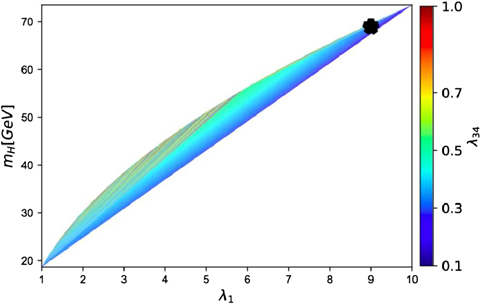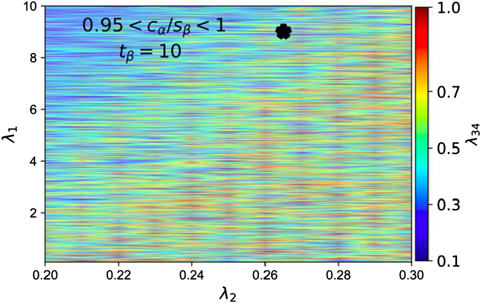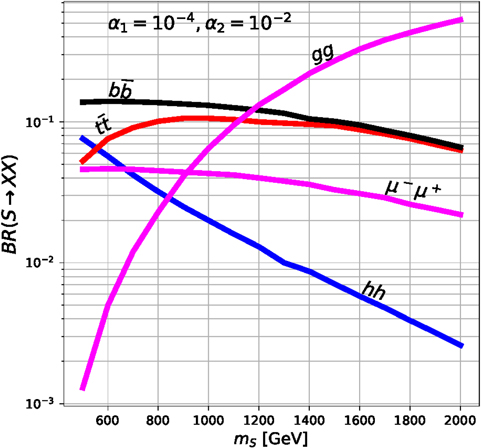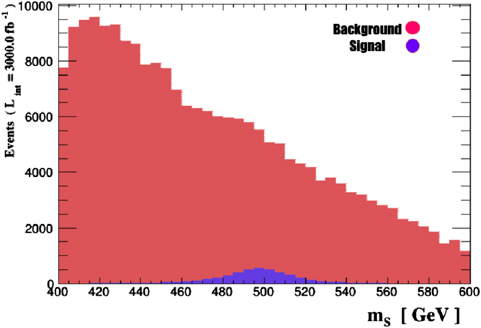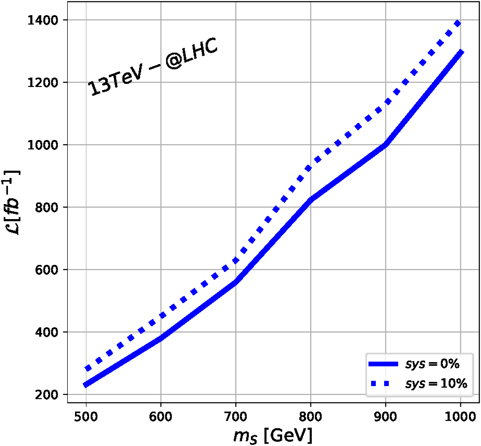Abstract
We determine the discovery potential of the Large Hadron Collider (LHC) at 13 TeV center-of-mass energy for a heavy scalar resonance in the dilepton channel. In particular, we consider the singlet-like heavy mass eigenstate of a mixed two Higgs doublet and scalar singlet model in the U(1)B−L extension of the standard model. We find that, despite the small coupling of the singlet scalar with the doublets, this heavy scalar can be discovered with 5σ at the LHC with integrated luminosities of ∼300 to 1400 fb−1 in the mass range between 500 GeV and 1 TeV.
Export citation and abstract BibTeX RIS

Original content from this work may be used under the terms of the Creative Commons Attribution 4.0 licence. Any further distribution of this work must maintain attribution to the author(s) and the title of the work, journal citation and DOI.
1. Introduction
The discovery of a scalar resonance with a mass of 125 GeV at the Large Hadron Collider (LHC) has at first glance completed the standard model (SM) of particle physics [1, 2]. However, it is well known that the abundance of dark matter in the Universe and the origin of neutrino masses cannot be explained within the SM. Both of these problems can, however, be solved by extending the Higgs sector and connecting it to dark matter and neutrinos through the so-called Higgs portal [3, 4]. Extensions containing two Higgs doublets and/or additional singlets have been shown to be particularly successful for neutrinos [5–10], dark matter [11–25], with respect to the stringent limits on flavor-changing neutral currents (FCNCs) [26–29], or all of the above [30–33]. These extra scalars have been studied in the literature in the context of effective, simplified and UV-complete models. While for the first two the parameter space remains large and ambiguous, the parameters in UV-complete models are closely connected to each other, making their study more challenging, but also more consistent.
U(1)X gauge extensions of the SM with an extended Higgs sector can explain the current relic abundance of dark matter in the Universe with scalar singlet, doublet or triplet dark matter [34–36] and the origin of neutrino masses through the seesaw mechanism [37]. Recently, LHC lower limits on the masses of the new gauge bosons predicted by different extra gauge symmetries have been imposed [38–40]. Current dark matter experimental bounds on the Z − Z' mixing angle have been shown to leave open some parameter space that can be explored by upcoming experiments [36]. Here, we turn to the scalar sector and explore the sensitivity of the LHC to heavy scalar resonances in the U(1)B−L gauge extension. Our study extends similar earlier studies for twin and composite Higgs models [41], the NMSSM [42], and in particular [43–45].
The LHC will remain the most powerful accelerator in the world for at least the next two decades. After the 2023–2025 upgrade, it will reach integrated luminosities of ∼1000 fb−1 or more [46]. During the following high-luminosity (HL) phase, it will explore and potentially discover signals that were until then too small or hidden in large backgrounds (table 1).
Table 1. U(1)B−L charges for all fermions and scalars of our model. In particular, this assignment of charges is able to explain neutrino masses and the absence of flavor-changing currents in the type-I 2HDM.
| Fields | uR | dR | QL | LL | eR | NR | Φ2 | Φ1 | Φs |
|---|---|---|---|---|---|---|---|---|---|
| Charges | u | d |

|

| −(2u + d) | −(u + 2d) |

|

| 2u + 4d |
| U(1)B−L | 1/3 | 1/3 | 1/3 | −1 | −1 | −1 | 0 | 2 | 2 |
2. The model
We consider a U(1)X extension of the SM gauge symmetry group that contains in addition to the SM particle content right-handed neutrinos, a two Higgs doublet model (2HDM), and a scalar singlet field. We focus on the U(1)B−L symmetry because it is known to have many important implications in cosmology. In particular, the model is able to explain neutrino masses, while being at the same time free of FCNCs. It therefore resembles the type-I 2HDM with an additional singlet, where only one scalar doublet contributes to the SM fermion masses via the Yukawa Lagrangian

Here, the scalar doublets are written as

while the scalar singlet is  .
.
Models with additional U(1)X gauge symmetries and extended scalar sectors generally have reduced scalar potentials. Also our scalar potential includes fewer operators than the usual 2HDM with an additional singlet due to the U(1)B−L charge assignments of the scalar fields. In particular, the scalar doublets Φ1 and Φ2 have to transform differently under U(1)B−L in order to prevent FCNCs. At lower energies, this effect then plays the role of the Z2 symmetry that is typically employed to stabilize dark matter. This setup also affects the mass spectrum of the scalar sector. The pure doublet and singlet-doublet parts of our scalar potential read


Note the absence of the λ5 operator typical for 2HDMs, which gives mass to the psedoscalar. This mass is generated here by the interaction of the scalar doublets with the singlet, requiring the parameters μi of the potential to be non-zero in order to avoid massless Goldstone bosons.
We are interested in a particular framework, in which there is a mH < mh ≪ mS mass hierarchy. This framework will allow us to make consistent scans with a weakly coupled heavy scalar S and light scalar H, while h remains SM-like. In general, the neutral CP-even scalar mass eigenstates mix as

The mixing angles α, α1 and α2 depend on the parameters of the scalar potential and on the vacuum expectation values (VEVs) of the scalars. In the limit of μi ≪ 1 (α1, α2 ≪ 1), the angle α coincides with the mixing angle of the usual 2HDM with the H-h mixing given by [47]

and

For the pseudoscalar and charged scalar we obtain

and

with  . In the limit α1,2 ≪ 1, the scalar masses can be approximated by
. In the limit α1,2 ≪ 1, the scalar masses can be approximated by

where clearly the scalar singlet can be seen as if it had decoupled form the doublets. Its mass then depends only on its self-coupling λs and VEV vs .
As one can observe from equation (10), the masses of the SM-like Higgs boson h and the lighter boson H are coupled, and their splitting depends in particular on the combined parameter λ34 = λ3 + λ4. In figure 1 we show the available parameter space in the λ1,2,34 plane compatible with the current measurement of the SM-like Higgs boson mass mh for a ratio of the Higgs doublet VEVs tβ = tan β = v2/v1 = 10. We stress that all scanned points shown here are compatible with the stability and perturbativity of the potential as required [48, 49]. The black star denotes the benchmark point that we will consider in our phenomenological studies. The first conclusion that we can draw form figure 1 is that the available parameter space is strongly affected by imposing the mass of the SM-like Higgs boson, requiring the parameter λ2 to lie in the narrow window [0.21–0.27] for 0.01 < λ1 < 10 and 0.1 < λ34 < 1.
Figure 1. Parameter space in the λ1,2,34 plane compatible with current measurements of the SM Higgs boson mass mh for a ratio of Higgs doublet VEVs tβ = tan β = v2/v1 = 10. Our benchmark point is shown in black.
Download figure:
Standard image High-resolution imageIn figure 2 we show the dependence of the mass of the lighter Higgs boson H coming from the second doublet in the region compatible with the measured mass of the SM-like Higgs boson h. As one can see, mH depends almost linearly on λ1 for small values of λ34 < λ1 and fixed mh . The black star denotes again our benchmark scenario, which we have chosen to avoid low-energy constraints coming from the STU parameters. This is achieved by selecting a mass of the pseudoscalar Higgs boson A in equation (8) that is nearly degenerate with mH . For our benchmark point with tβ = 10, vs = 6 × 104 GeV and μs = 1 × 10−2 GeV, we obtain mA = 72 GeV, which is selected to be nearly degenerate with mH and thus compatible with the STU requirements.
Figure 2. Dependence of the mass of the lighter Higgs H on the self-couplings λ1 and λ34. Our benchmark point is shown in black.
Download figure:
Standard image High-resolution imageThe couplings of the SM fermions to the CP-even scalars are given in table 2. In the weak coupling limit of the heavy scalar singlet, they reduce to those given in table 3. As figure 3 shows, SM-like branching ratios 0.95 < cos α/ sin β < 1 of the Higgs boson h can be achieved in all regions of our coupling parameter space. We have also verified that for our benchmark point, shown again in black, the lighter CP-even Higgs boson H has a branching ratio BR , which makes its discovery difficult due to the large QCD backgrounds. The same goes for the charged scalar H+ decays into
, which makes its discovery difficult due to the large QCD backgrounds. The same goes for the charged scalar H+ decays into  or τ+
ντ
.
or τ+
ντ
.
Table 2. Scalar coupling constants of the SM fermions.
| Vertex | Coupling constant |
|---|---|

|

|

|

|

|

|
Table 3. Same as table 2 in the limit α1, α2 ≪ 1.
| Vertex | Coupling constant |
|---|---|

|

|

|

|

|

|
Figure 3. Compatibility of the 2HDM with an additional scalar singlet with SM-like fermionic branching ratios of the Higgs boson h for tβ = 10. Our benchmark point is shown in black.
Download figure:
Standard image High-resolution imageExtensions of the gauge group can in principle have a large impact on the branching ratios of the scalars to gauge bosons, which scale with the gauge coupling constant. While this is not relevant for the light Higgs boson H, as mH < 2mW,Z , it could well be of importance for the prime object of our interest, the heavy scalar S. In U(1)X extensions of the SM, kinetic mixing between the neutral gauge bosons occurs due the mixing of the field strength tensors Bμν and Xμν of U(1)Y and U(1)B−L ,

We set the kinetic mixing parameter to  = 10−4 in accordance with the experimental constraints [50, 51] with the result that the branching ratios of the heavy scalar S to SM gauge bosons are also suppressed, while the decay into two Z' bosons is in principle allowed.
= 10−4 in accordance with the experimental constraints [50, 51] with the result that the branching ratios of the heavy scalar S to SM gauge bosons are also suppressed, while the decay into two Z' bosons is in principle allowed.
Additional mixing arises from the neutral gauge boson mass terms, since the scalar doublet Φ1 is charged under B − L and contributes to the Z' mass. This mixing is, however, small in our case, since vs
≫ v1. For large vs
, the new gauge boson mass is given by  , where qS
= 2 is the charge of the singlet scalar under the new gauge symmetry. Its dependence on vs
is shown in figure 4 for different values of the new gauge goupling gB−L
. We choose gB−L
= 0.1 in accordance with the latest LHC limits [52].
, where qS
= 2 is the charge of the singlet scalar under the new gauge symmetry. Its dependence on vs
is shown in figure 4 for different values of the new gauge goupling gB−L
. We choose gB−L
= 0.1 in accordance with the latest LHC limits [52].
Figure 4. Mass of the extra gauge boson mZ' as a function of the singlet VEV vs for two values of gB−L = 0.1 and gB−L = 0.01. Our benchmark point is shown in black.
Download figure:
Standard image High-resolution imageIn the following, we focus on the production and decay of the new heavy scalar S. Once the scalar bosons have mixed, they share all the production and decay channels allowed by the symmetries. The decay channels depend not only on the available phase space, but are also strongly model-dependent. Depending on the values of vs and gB−L , scalar decays into Z'Z' or Z'Z will be allowed by phase space. We have adopted scenarios, where those channels are closed by phase space, and focus instead on direct decays to SM particles. While these channels can provide information on the new gauge coupling, we leave their exploration for future work.
When the coupling of the heavy singlet S to both doublets is very small (μi
∼ 10−6 and α1,2 ∼ 10−4), it decays primarily into hh and Hh, as we can see in figure 5. The reason is that the corresponding partial widths are proportional to vs
(see appendix
Figure 5. Dominant branching ratios of the heavy scalar S as a function of its mass for mixing angles α1 = α2 = 10−4.
Download figure:
Standard image High-resolution image3. LHC phenomenology of a heavy singlet-like Higgs boson
Let us now explore the hypothesis of a heavy Higgs boson with mass at the TeV scale. We want to estimate its discovery prospects at the HL-LHC with 13 TeV center-of-mass energy. As we have adopted a scenario of a weakly coupled singlet-like scalar S, the mixing angles α1,2 have to be small. We first examine further its branching ratios in the two scenarios α1 = α2 = 10−4 and α1 = 10−4, α2 = 10−2. The dominant channels for both cases were shown in figures 5 and 6. For the first case, the large branching ratios to hh and Hh seem promising at first sight. Unfortunately, the tiny production cross section makes this scenario inconceivable for the current and prospective luminosities of the LHC and HL-LHC, as one can see from figure 7 (left). Therefore, we focus on the second scenario in order to see if it is possible with the upgrade of the LHC and HL-LHC to explore the TeV-scale parameter space in the scalar sector of our model. For this scenario, where α1 = 10−4 and α2 = 10−2, we obtain a large dijet signal, which suffers, however, from a huge QCD background. The dimuon channel is therefore most promising, as its dominant background is SM Z-boson production.
Figure 6. Same as figure 5 for mixing angles α1 = 10−4 and α2 = 10−2.
Download figure:
Standard image High-resolution imageFigure 7. Left: total production cross sections of heavy scalars S for scenarios with α1 = α2 = 10−4 and α1 = 10−4, α2 = 10−2. Right: upper limit on the gluon–gluon fusion production of scalars decaying into dimuons imposed by the ATLAS collaboration (black) and our model prediction assuming α1 = 10−4 and α2 = 10−2 (blue).
Download figure:
Standard image High-resolution imageTo show the potential of the HL-LHC to discover a heavy Higgs boson that couples to a new gauge sector, we simulate the gluon fusion process for our benchmark model,

where l− and l+ represent electrons or muons. We implement the U(1)B−L
model and its interactions with the help of FeynRules [53] and simulate the partonic events with MadGraph5 [54]. One extra jet is also taken into account in the simulation in order to better estimate the kinematic distributions and cross sections. Hadronization and detector effects were taken into account with the Pythia8 [55] and Delphes3 [56] interfaces to MadGraph5, respectively, within the kT-MLM jet matching scheme [57]. The one-loop S production through gluon-fusion has been implemented following the lines of reference [58]. The relevant backgrounds for our signals are the Z, h, γ, bZ, WZ and  production processes. They were simulated with the same tools as those used in the signal simulation. In order to suppress these backgrounds and select the candidate signal events we adopt the following basic cuts:
production processes. They were simulated with the same tools as those used in the signal simulation. In order to suppress these backgrounds and select the candidate signal events we adopt the following basic cuts:


where pTn
denotes the nth hardest lepton of the event. We reject events with missing transverse energy larger than 40 GeV in order to eliminate WZ and  events. Backgrounds with bottom jets are efficiently cleaned up with lepton isolation criteria. Finally, a hard cut on the two-lepton invariant mass mS
− 40 GeV < mℓℓ
< mS
+ 40 GeV helps to identify typical leptons from a heavy resonance decay.
events. Backgrounds with bottom jets are efficiently cleaned up with lepton isolation criteria. Finally, a hard cut on the two-lepton invariant mass mS
− 40 GeV < mℓℓ
< mS
+ 40 GeV helps to identify typical leptons from a heavy resonance decay.
In figure 8, we compare the signal of the heavy resonance of mass 500 GeV in the invariant mass distribution of the dilepton system to the background, which is still large before the kinematic cuts. After these cuts, the signal can be made visible at the level of 5σ at the HL-LHC. Figure 9 then shows the required luminosity at 13 TeV center-of-mass energy for this significance, computed with the significance metric  , where x presents the assumed systematic error. The continuous line shows the ideal case with negligible systematic errors, while the dashed line assumes a systematic error of 10%. As an example, in table 4 we show the cut-flow chart for a heavy scalar of mS
= 500 GeV and an integrated luminosity of 220 fb−1 without systematic error (x = 0). We observe that the current LHC with 100 fb−1 of integrated luminosity cannot discover these singlet-like scalars, as their TeV-scale signals are still covered by too large backgrounds. However, in the near future, after the LHC luminosity upgrade scheduled for 2023 to 2025, it will become possible to explore singlet-like scalars up to masses of ∼1 TeV despite the fact that they are heavy, only weakly coupled, constrained by the SM-like Higgs mass and branching ratios and are derived from UV-complete models with additional theoretical constraints.
, where x presents the assumed systematic error. The continuous line shows the ideal case with negligible systematic errors, while the dashed line assumes a systematic error of 10%. As an example, in table 4 we show the cut-flow chart for a heavy scalar of mS
= 500 GeV and an integrated luminosity of 220 fb−1 without systematic error (x = 0). We observe that the current LHC with 100 fb−1 of integrated luminosity cannot discover these singlet-like scalars, as their TeV-scale signals are still covered by too large backgrounds. However, in the near future, after the LHC luminosity upgrade scheduled for 2023 to 2025, it will become possible to explore singlet-like scalars up to masses of ∼1 TeV despite the fact that they are heavy, only weakly coupled, constrained by the SM-like Higgs mass and branching ratios and are derived from UV-complete models with additional theoretical constraints.
Figure 8. Dilepton invariant mass distribution for a singlet-like scalar boson of mass ms = 500 GeV (blue) and its SM background (red) before cuts and for an integrated luminosity of 3000 fb−1.
Download figure:
Standard image High-resolution imageFigure 9. Required luminosity of the HL-LHC at 13 TeV center-of-mass energy to discover a singlet-like Higgs boson S with 5σ as a function of its mass for an assumed systematic error or 10% (dotted line) and 0% (continuous line).
Download figure:
Standard image High-resolution imageTable 4. Cut-flow chart for mS = 500 GeV and an integrated luminosity of 220 fb−1 at the LHC with 13 TeV and without systematic errors (x = 0).
| Cuts | Signal | Background | Significance |
|---|---|---|---|
| Initial (no cut) | 1130 | 983 000 | 1.1 |
| pT1,2 > 20 GeV | 1050 | 732 200 | 1.2 |
| |ηℓ | < 2.5 | 1045 | 511 800 | 1.4 |
| m2ℓ > 250 GeV | 945 | 114 000 | 2.7 |
| Hard cut on mℓℓ | 181 | 1109 | 5.0 |
4. Conclusions
We have discussed the phenomenology of a TeV-scale scalar field living in a U(1)B−L gauge extension of the SM that contains both a 2HDM and a scalar singlet. The model is known to explain neutrino masses in a flavor-safe framework and can be extended in a straightforward way to also explain dark matter, e.g. by the addition of a vector-like fermion. In this case the heavy scalar would be the witness of an underlying broken gauge symmetry rather than an ad-hoc Z2 symmetry typically invoked to stabilize dark matter. We focused on the scenario in which the singlet scalar is weakly coupled to the 2HDM sector. In this scenario, the known mass and branching ratios of the SM-like Higgs boson can be used to restrict several of the model parameters. We studied the discovery reach of the LHC with a center-of-mass energy of 13 TeV for such a heavy singlet-like scalar decaying to dileptons. We found that the HL-LHC with integrated luminosities of ∼1400 fb−1 allows for a discovery of these heavy Higgs bosons up to masses of about 1 TeV.
Acknowledgments
DC thanks the University of Münster for hospitality and financial support through a WWU fellowship as well as MEC and UFRN. The work of MK and SZ is supported by the DFG through the Research Training Network 2149 'Strong and weak interactions—from hadrons to dark matter'.
Appendix: A
Partial widths of singlet-like heavy Higgs bosons The partial widths of the heavy scalar S for the decay channels relevant to our study ( and Z'Z) in the small coupling limit (α1,2 ≪ 1) are given by:
and Z'Z) in the small coupling limit (α1,2 ≪ 1) are given by:







Here, we have defined sξ
= sin ξ and cξ
= cos ξ, sβ
= sin β and sα
= sin α for simplicity. Gauge kinetic terms and gauge boson masses in the canonical basis, the gauge covariant derivative for small  reads
reads

or explicitly

Here, we have defined

with  being the hypercharge of the scalar doublet, which in the 2HDM is taken equal to +1 for both scalar doublets, and
being the hypercharge of the scalar doublet, which in the 2HDM is taken equal to +1 for both scalar doublets, and  being the charge of the scalar doublet i under U(1)X
. From the part of the Lagrangian responsible for the gauge boson masses, we can extract the relevant terms
being the charge of the scalar doublet i under U(1)X
. From the part of the Lagrangian responsible for the gauge boson masses, we can extract the relevant terms

with

and

as well as

This leads to the gauge boson mass matrix

The above expression, equation (29), representing the mixing between the SM Z-boson and the new gauge boson X, is valid for arbitrary U(1)X charges of singlet and doublet scalars. It is important to notice that, when QX1 = QX2 and there is no singlet contribution, the determinant of the matrix equation (29) is zero. The matrix in equation (29) is diagonalized through a rotation O(ξ)

Its mass eigenvalues are


while the mixing angle ξ is determined by

Since this mixing angle is supposed to be small, as  , we can approximate tan ξ with
, we can approximate tan ξ with

and expand this equation further, substituting the expressions for GXi and factoring out the mZ mass, to obtain



